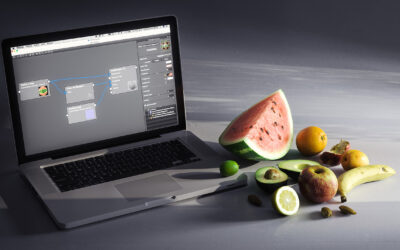Once again, the numbers have aligned, the digits are primed and the expansive importance of numerical magnitudes boggle and delight the mind. Yes, it is Pi (π) Day and to celebrate this day of days we bring to you… an illusion. An illusion that will confound your friends, bring joy to lovers of gray and even more joy to those who appreciate optical phenomena. We bring you Ted Adelson’s Checker Shadow Illusion, and we bring it to you as a KeyShot scene for you to download a share with others. How does the illusion work?
![]() Download Checker Shadow Illusion
Download Checker Shadow Illusion
First, download the KeyShot .ksp file above. Open in KeyShot, then look at the two squares with the KeyShot logo. They are in fact the same shade of gray.
Adelson explains it. From his website:
The visual system needs to determine the color of objects in the world. In this case the problem is to determine the gray shade of the checks on the floor. Just measuring the light coming from a surface (the luminance) is not enough: a cast shadow will dim a surface, so that a white surface in shadow may be reflecting less light than a black surface in full light. The visual system uses several tricks to determine where the shadows are and how to compensate for them, in order to determine the shade of gray “paint” that belongs to the surface.
The first trick is based on local contrast. In shadow or not, a check that is lighter than its neighboring checks is probably lighter than average, and vice versa. In the figure, the light check in shadow is surrounded by darker checks. Thus, even though the check is physically dark, it is light when compared to its neighbors. The dark checks outside the shadow, conversely, are surrounded by lighter checks, so they look dark by comparison.
A second trick is based on the fact that shadows often have soft edges, while paint boundaries (like the checks) often have sharp edges. The visual system tends to ignore gradual changes in light level, so that it can determine the color of the surfaces without being misled by shadows. In this figure, the shadow looks like a shadow, both because it is fuzzy and because the shadow casting object is visible.
The “paintness” of the checks is aided by the form of the “X-junctions” formed by 4 abutting checks. This type of junction is usually a signal that all the edges should be interpreted as changes in surface color rather than in terms of shadows or lighting.
As with many so-called illusions, this effect really demonstrates the success rather than the failure of the visual system. The visual system is not very good at being a physical light meter, but that is not its purpose. The important task is to break the image information down into meaningful components, and thereby perceive the nature of the objects in view.
It’s quite amazing. When our minds interpret the 3-dimensional scene, it immediately estimates all lighting and shadow to determine the properties of the materials. To see more on the project and other illusions visit Adelson’s original Checker Shadow Illusion website.








0 Comments